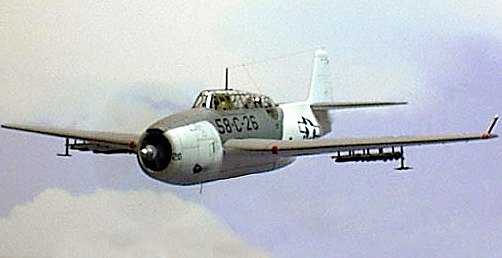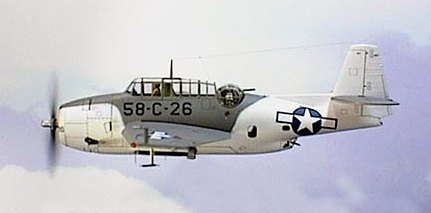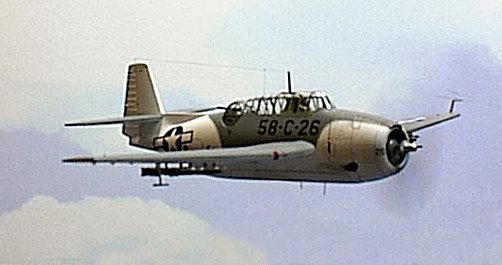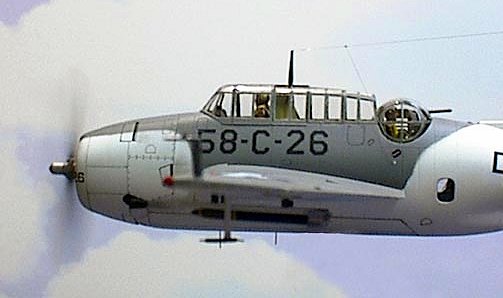
|
KIT: |
Hasegawa 1/72 TBM-1 Avenger |
|
KIT # |
51333 |
|
PRICE: |
$18.98 |
|
DECALS: |
See review |
|
REVIEW & |
|
|
NOTES: |
|
"TURKEY AT BLACK GAP"
EASTERN AIRCRAFT TBM-1
SQUADRON VC-58, USS GUADALCANAL (CVE-60)
MID-ATLANTIC - JANUARY 1944
|
HISTORY |

The model I have done represents one of two Eastern Aircraft TBM-1C "Avenger" aircraft that executed the first American rocket attack of World War II on January 11, 1944. Both aircraft operated from the escort carrier USS GUADALCANAL with Composite Squadron VC-58 doing hunter-killer ASW (anti-submarine warfare) operations in the middle Atlantic. The rocket attack was against the German submarine U-758 and although not sunk, the submarine had to return to port with heavy damage and was scrapped.
The flight crew for 58-C-26 on that day was LT JG L. L. Mc Ford, pilot; ARMS3/c Charles Gertsch, bombardier/radio operator; and AMM2/c W.H. Ryder, rear turret gunner.
|
CONSTRUCTION |
Interior:
Sidewalls added using styrene strip. Accessory boxes, throttle, and such done with styrene sheet. Kit's cockpit floor was cut away on the starboard side for access of bombardier to rear compartment. Seat belts for unused bombardier's seat were from True Details. Gunsight reflector glass cut from clear sheet styrene.
The rear turret was spruced up with armor plating from styrene sheet and armored glass from .30 clear styrene sheet. Gun control box and handle were done with styrene sheet and copper wire. Copper wire also used for turret electric wiring. The gun opening cover was cut from styrene strip. The area in front of the seat had to be cut out to make room for my gunner.
Crew figures came from IPMS members. The rear turret gunner is actually a HO (1/87-scale) figure with a 1/72-scale head grafted on. The 1/72nd scale figure would not fit in the seat provided. Although not well seen, I chose to put my bombardier/radio operator in the rear compartment where he most often flew on combat missions. For this reason I had to scratch-built the compartment (seats, radio boxes, ammo containers, and such).
I didn't like the representations of the kit's turret and ventral gun barrels (the turret barrel looked like a 30 caliber and the ventral barrel looked like a 50 caliber). I used hypo tubing of an appropriate size to represent the turret gun as a 50 caliber and the ventral gun as a 30 caliber. I added handles to the ventral gun using styrene tubing. The cartridge ejection bag on the turret gun was done with styrene sheet coated with epoxy to round it out.
Exterior:
 The kit's Yagi
radar pieces were carefully drilled to except .010 stainless steel wire to more
properly represent these units. The Mk-4 rocket rails were scratch-built using
Plastistrut u-shaped strip and styrene rod. These were attached to drilled out
flash holes for the Mk-5 rocket launchers supplied with the kit. The rockets
came from a HASEGAWA P-38 kit. They were drilled out at the rear and a piece of
34-gauge aluminum thread was inserted into the opening and the rear of the rail
to represent the electric ignition wires for the rockets. Smoke-colored
invisible thread was used for the aerial wiring.
The kit's Yagi
radar pieces were carefully drilled to except .010 stainless steel wire to more
properly represent these units. The Mk-4 rocket rails were scratch-built using
Plastistrut u-shaped strip and styrene rod. These were attached to drilled out
flash holes for the Mk-5 rocket launchers supplied with the kit. The rockets
came from a HASEGAWA P-38 kit. They were drilled out at the rear and a piece of
34-gauge aluminum thread was inserted into the opening and the rear of the rail
to represent the electric ignition wires for the rockets. Smoke-colored
invisible thread was used for the aerial wiring.
Although not seen, I had to do quite a bit of cutting, thinning, and model engineering to properly represent the landing gear in the retracted position. I also sanded the bulge at the rear of the fuselage that represented the tailhook and scratch-built a more believable unit from styrene rod.
No modifications were done to the engine other than adopting it and the propeller to except two sizes of brass tubing so that the prop would spin with the slightest breeze. Kids of all ages are invited to blow it; JUST DON'T SPIT!
|
PAINT & DECALS |
 Clear areas
were masked with Bare-metal foil and given a coat of interior green before
priming the entire model with Krylon Flat White primer shot through the
airbrush. Once dried and sanded the lower surfaces were giver two coats of Polly
Scale White. Masks were cut for the lower surfaces and the upper surfaces were
sprayed Polly Scale Dark Gull Gray. The model was next given two coats of Polly
Scale Clear Gloss for decal prep. Only the vertical tail IDs were taken from the
kit's decal sheet. All National Insignia, in addition to the lettering and
numbering were take from Superscale decal sheets. Once dried and cleaned, all
recessed controls and accesses were given dark gray and black ink washes. All
was sealed in an additonal gloss coat followed by two coats of Polly scale Clear
Flat. Exhausts stains were lastly applied using dark gray and black powdered
pastels. Wing lights were painted clear red and clear green as required.
Clear areas
were masked with Bare-metal foil and given a coat of interior green before
priming the entire model with Krylon Flat White primer shot through the
airbrush. Once dried and sanded the lower surfaces were giver two coats of Polly
Scale White. Masks were cut for the lower surfaces and the upper surfaces were
sprayed Polly Scale Dark Gull Gray. The model was next given two coats of Polly
Scale Clear Gloss for decal prep. Only the vertical tail IDs were taken from the
kit's decal sheet. All National Insignia, in addition to the lettering and
numbering were take from Superscale decal sheets. Once dried and cleaned, all
recessed controls and accesses were given dark gray and black ink washes. All
was sealed in an additonal gloss coat followed by two coats of Polly scale Clear
Flat. Exhausts stains were lastly applied using dark gray and black powdered
pastels. Wing lights were painted clear red and clear green as required.
 Article and
photographs © Caz Dalton 1996/1999
Article and
photographs © Caz Dalton 1996/1999
Published May 2000
If you would like your product reviewed fairly and quickly by a site that has over 800 visits a day, please contact me or see other details in the Note to Contributors.